The optical pass maintenance ratio of metal halide fishing lamps is one of the important technical indicators of metal halide fishing lights. With the increasing demand of metal halide fishing lights in China and the continuous improvement of the technical level, the optical pass maintenance ratio of metal halide fishing lights is becoming more and more important. This paper focuses on the mechanism and practice of its in-depth analysis and research.
Maintenance analysis of a metal halide fishing light pass
Filling series metal halide, different power, different design of the structure of the metal halide lamp the optic maintain rate curve is different, such as most of the metal halide lamp fishing at the beginning of the lamp ignition (two hundred hours) a couple of hours to a ︿ flux decline faster, continue to light the luminous flux decline is more smooth. However, there are also some metal halide fishing lamps with different light-pass maintenance curve, and the decline rate of light flux at the initial ignition point is basically similar to that at the later ignition point. The differences above are mainly due to the similar but different reasons for the decrease of light flux in the early and late period of ignition point. In order to further analyze the causes of light flux decline in the ignition point of metal halide lamps, it is necessary to analyze the mechanism of light decay in the early and late burning point of the lamps, so as to effectively improve the light pass maintenance rate of the lamps.
Firstly, the mechanism of flux decline at the initial ignition point is analyzed. For example, the arc tube of a certain metal halide fishing lamp includes: the size and shape of quartz bubble shell and electrode; Electrode extension length; Cold end temperature (including insulation coating size and coating thickness); After the ratio and dosage of filled gold halogen pills and input arc power are determined, the change of optical transmittance is basically determined by: 1. The change of optical transmittance of quartz bubble shell. 2. Changes in electrode emission performance (including cathode potential drop). 3. Changes in atomic concentration and atomic distribution of luminous elements (Na, Sc, Dy, Hg–, etc.) in arc tubes of metal halide lamps.
Since the total atomic radiation intensity in the underwater metal halide fishing lamp arc tube depends on the concentration of excited atoms, its expression is as follows:
N¿=No(gk/g,)exp-(eVk/kT)·
Where N0 is the atomic concentration of various luminous elements. Vk is the excitation potential energy of various luminescent elements. T is the temperature where the atoms of each element are. Since there is a large temperature difference at different points in the arc tube when the metal halide lamp is at the ignition point, Figure 1 shows the isothermal curve diagram of the arc tube of 2000w metal halide fishing lamp.
Figure 1. Plasma temperature profile of 2000w metal halide fishing lamp. The electrode distance is 4.2mm and the isotherm distance is 250K
It can be seen from the above equation that the same number of luminous element atoms have different luminous intensity in different isotherm regions. The concentration of NaI, ScI3 and other metal halide molecules in the saturated vapor pressure state is determined by the cold end temperature of the arc tube, the liquid metal halide surface area attached to the quartz tube wall near the cold end (determined by the metal halide filling amount, the shape and state of the cold end surface) and the flow velocity through the liquid metal halide surface. It can be seen that the cold end of the arc will greatly affect the atomic concentration and distribution state, of course, will affect the luminescence intensity of metal halide lamp. It is not difficult to observe the liquid phase metal halide distribution near the cold end of the metal halide fishing lamp in the ignition point carefully. It is not difficult to find that the liquid phase metal halide distribution near the cold end of the metal halide lamp changes greatly in the early hours to tens of hours of the ignition point (especially the Sc-Na series metal halide lamp). Therefore, the atomic concentration distribution in the arc tube changes greatly, which is one of the main reasons for the large initial light decay of metal halide lamp.
Post time: Jun-19-2023

